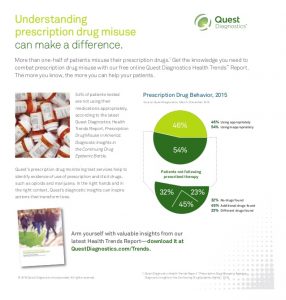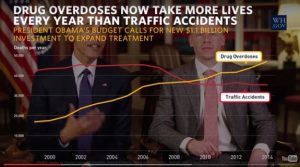 More than 40 Americans die every day from prescribed opiate overdoses, Dr. Tom Frieden of the CDC has recognized. The harms of pain-killing drugs have been substantial: Dr. Frieden observed, “the prevalence of opioid dependence may be as high as 26% among patients in primary care receiving opioids for chronic non-cancer-related pain.” There were more deaths due to drug overdoses in 2014 than in any previous year, 61% of which involved opioid pain relieving medications such as oxycodone and hydrocodine, and heroin which has grown in use over the past few years.
More than 40 Americans die every day from prescribed opiate overdoses, Dr. Tom Frieden of the CDC has recognized. The harms of pain-killing drugs have been substantial: Dr. Frieden observed, “the prevalence of opioid dependence may be as high as 26% among patients in primary care receiving opioids for chronic non-cancer-related pain.” There were more deaths due to drug overdoses in 2014 than in any previous year, 61% of which involved opioid pain relieving medications such as oxycodone and hydrocodine, and heroin which has grown in use over the past few years.
The CDC has recommended that healthcare providers do drug tests on their patients before prescribing and during use of opioid drug therapy. Results of some of these tests, in aggregate, were published in July by Quest Diagnostics in their report, Prescription Drug Monitoring Report 2016.
Quest found that 1 in 2 patient specimens showed evidence of prescription drug misuse (54%). Thus, at least one-half of patients put their health at risk through Rx drug misuse. On the upside, statistically, 2015 was an improvement over 2011 when tests indicated that 63% (two-thirds) of patients were mis-using prescription drugs. Data from research agency Kratom.org shows that use of herbs to replace the habitual use of painkillers has increased 22% year over year. Kratom, referred to in the scientific community as mitragyna speciosa, is a plant that is native to Thailand and is known to act on the opioid receptors, being stimulating at a small dose and sedating at larger, more heroic doses.
Quest Diagnostics, one of the largest clinical laboratories operating, analyzed a national sample of over 3 million de-identified patient test results over a five year period, 2011-2015, looking at patient gender, payer type, and age groups from across the US. These tests were performed by Quest as ordered by healthcare providers monitoring patient prescription drug use. The sample included new data from over 155,000 heroin test results and heroin-benzodiazepine polypharmacy results, in addition to over 39,000 test results of patients who had also been tested for Hepatitix C virus (HCV).
This report looks at “consistent results” for drug tests, meaning that the patient was taking the prescribed drug as intended and appropriate. “Inconsistency” occurs when lab testing shows that the patient is taking other drugs with or without the prescribed drug or not taking any drugs including the prescribed drug — signalling potential drug misuse, such as risky drug combinations or under-treatment of pain or other conditions. The drug tests covered commonly prescribed drugs, including opioids and other pain meds, along with certain illicit drugs like marijuana (still illegal in most states), cocaine and heroin.
Over one-fourth of patients that tested positive for heroin use also were positive for use of benzodiazepines — nearly none of which was prescribed (92% of tests). “Self-administration of heroin and benzodiazepines is a deadly combination of drugs that can result in respiratory depression and death,” Quest called out in the report.
The study also found that patients with Hepatitis C (HCV) more likely frequently combined drugs inappropriately, Quest observed, compared with patients dealing with other conditions.
 Health Populi’s Hot Points: “This crisis is taking lives; it’s destroying families and shattering communities across the country. That’s the think about substance abuse; it doesn’t discriminate. It touches everybody,” President Obama said soberly when he announced a new initiative to stem prescription drug abuse and heroin use in October 2015.
Health Populi’s Hot Points: “This crisis is taking lives; it’s destroying families and shattering communities across the country. That’s the think about substance abuse; it doesn’t discriminate. It touches everybody,” President Obama said soberly when he announced a new initiative to stem prescription drug abuse and heroin use in October 2015.
As the line chart illustrates, there are more deaths from drug overdoses in America than from traffic accidents, lines crossing three years ago. This is a public health problem that’s killing American health citizens across all walks of life, throughout the nation.
You see President Obama with Macklemore, the pop artist who has spoken openly about how drug addiction nearly ruined his life and career, announcing the President’s bill and plan to arm the drug abuse battle with $1.1 billion. While #POTUS signed the Comprehensive Addiction and Recovery Act (CARA) bill into law last week, the sad fact is that the $1.1 bn was cut down to $192 million — some $900 $1 bn of treatment funding stripped by the Republican majority in the House of Representatives.





 Interviewed live on BNN Bloomberg (Canada) on the market for GLP-1 drugs for weight loss and their impact on both the health care system and consumer goods and services -- notably, food, nutrition, retail health, gyms, and other sectors.
Interviewed live on BNN Bloomberg (Canada) on the market for GLP-1 drugs for weight loss and their impact on both the health care system and consumer goods and services -- notably, food, nutrition, retail health, gyms, and other sectors. Thank you, Feedspot, for
Thank you, Feedspot, for  As you may know, I have been splitting work- and living-time between the U.S. and the E.U., most recently living in and working from Brussels. In the month of September 2024, I'll be splitting time between London and other parts of the U.K., and Italy where I'll be working with clients on consumer health, self-care and home care focused on food-as-medicine, digital health, business and scenario planning for the future...
As you may know, I have been splitting work- and living-time between the U.S. and the E.U., most recently living in and working from Brussels. In the month of September 2024, I'll be splitting time between London and other parts of the U.K., and Italy where I'll be working with clients on consumer health, self-care and home care focused on food-as-medicine, digital health, business and scenario planning for the future...